AASB Standards and Financial Reporting Developments Dec 2017-Mar 2018
VerifiedAdded on 2023/06/14
|6
|1441
|248
Report
AI Summary
This report provides an overview of the changes and developments in the financial reporting environment from December 1, 2017, to March 31, 2018, as observed within the Australian Accounting Standards Board (AASB). It covers various updates, including revenue recognition from licenses issued by the public sector, amendments related to joint operations and business combinations, and discussions with the Accounting Standards Board of Japan (ASBJ) on financial activities reporting frameworks. The report also addresses the necessity for Australian organizations to adhere to AASB 101, focusing on the presentation of general-purpose financial reports and highlighting errors in the financial statements of Blake Limited, such as incorrect asset and liability classifications, improper accounting for investments, and misrepresentation of accumulated depreciation and dividend payments. The document emphasizes the importance of proper segregation and disclosure for better financial position overview.
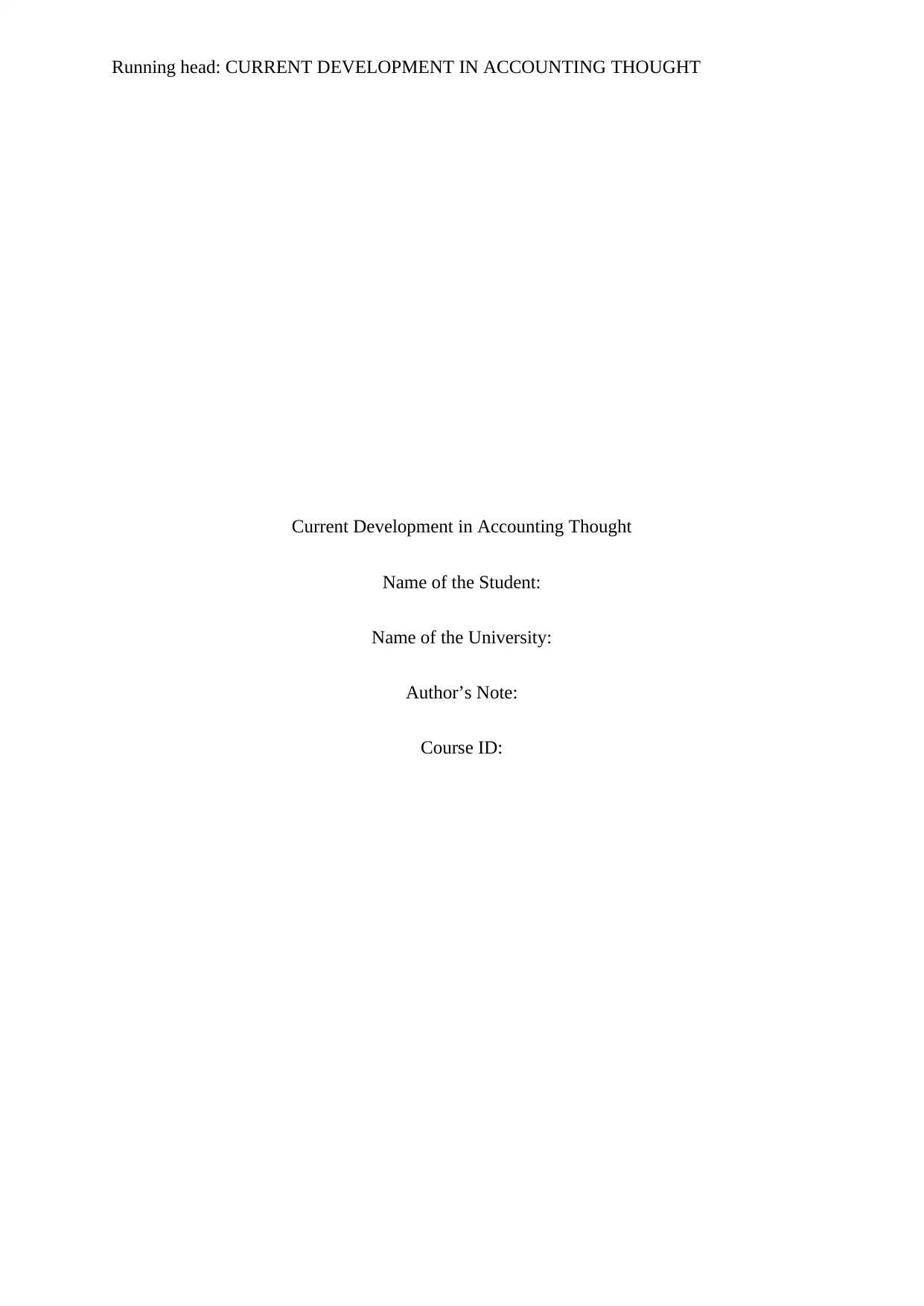
Running head: CURRENT DEVELOPMENT IN ACCOUNTING THOUGHT
Current Development in Accounting Thought
Name of the Student:
Name of the University:
Author’s Note:
Course ID:
Current Development in Accounting Thought
Name of the Student:
Name of the University:
Author’s Note:
Course ID:
Paraphrase This Document
Need a fresh take? Get an instant paraphrase of this document with our AI Paraphraser
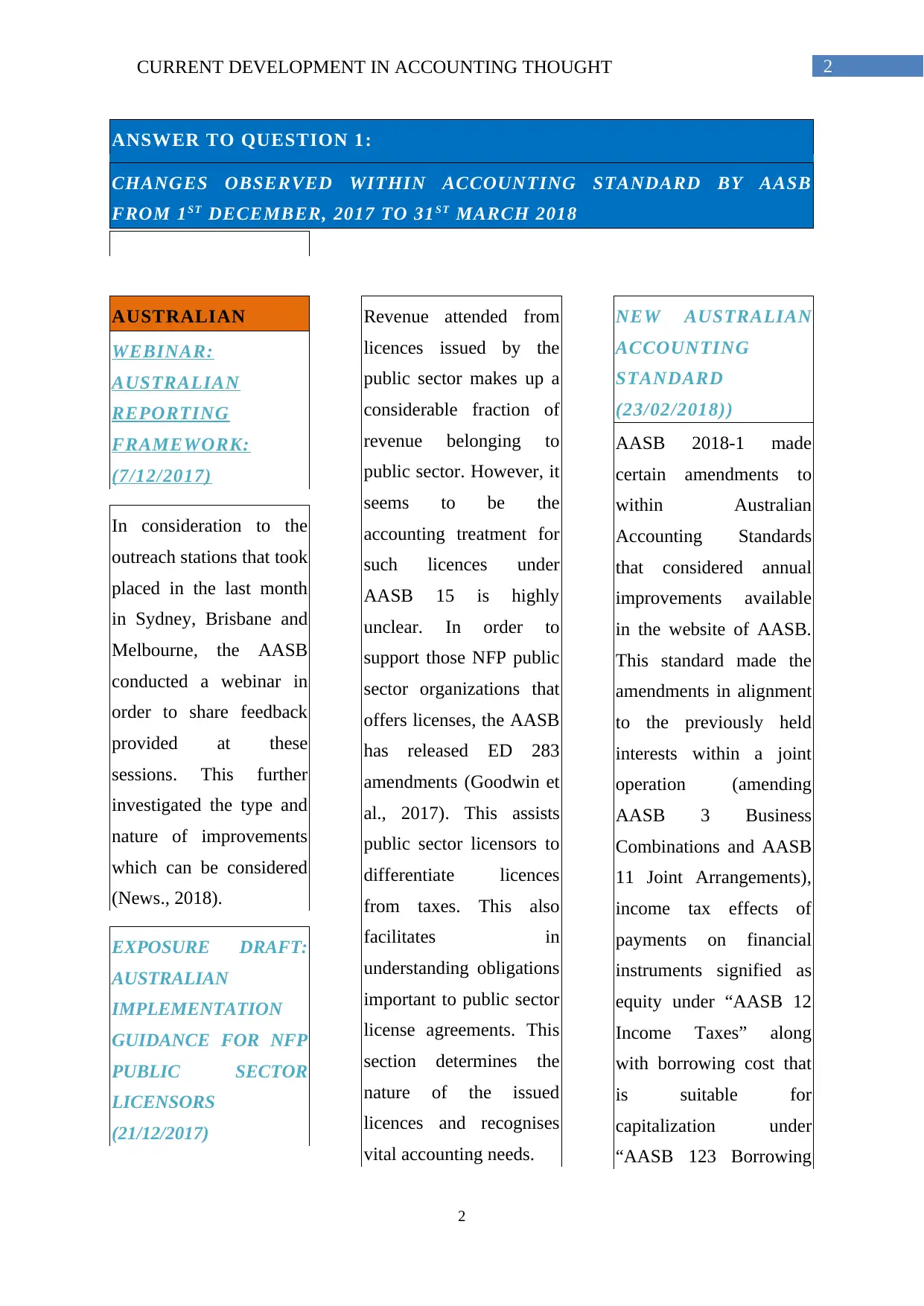
2CURRENT DEVELOPMENT IN ACCOUNTING THOUGHT
ANSWER TO QUESTION 1:
CHANGES OBSERVED WITHIN ACCOUNTING STANDARD BY AASB
FROM 1ST DECEMBER, 2017 TO 31ST MARCH 2018
AUSTRALIAN
WEBINAR:
AUSTRALIAN
REPORTING
FRAMEWORK:
(7/12/2017)
In consideration to the
outreach stations that took
placed in the last month
in Sydney, Brisbane and
Melbourne, the AASB
conducted a webinar in
order to share feedback
provided at these
sessions. This further
investigated the type and
nature of improvements
which can be considered
(News., 2018).
EXPOSURE DRAFT:
AUSTRALIAN
IMPLEMENTATION
GUIDANCE FOR NFP
PUBLIC SECTOR
LICENSORS
(21/12/2017)
Revenue attended from
licences issued by the
public sector makes up a
considerable fraction of
revenue belonging to
public sector. However, it
seems to be the
accounting treatment for
such licences under
AASB 15 is highly
unclear. In order to
support those NFP public
sector organizations that
offers licenses, the AASB
has released ED 283
amendments (Goodwin et
al., 2017). This assists
public sector licensors to
differentiate licences
from taxes. This also
facilitates in
understanding obligations
important to public sector
license agreements. This
section determines the
nature of the issued
licences and recognises
vital accounting needs.
NEW AUSTRALIAN
ACCOUNTING
STANDARD
(23/02/2018))
AASB 2018-1 made
certain amendments to
within Australian
Accounting Standards
that considered annual
improvements available
in the website of AASB.
This standard made the
amendments in alignment
to the previously held
interests within a joint
operation (amending
AASB 3 Business
Combinations and AASB
11 Joint Arrangements),
income tax effects of
payments on financial
instruments signified as
equity under “AASB 12
Income Taxes” along
with borrowing cost that
is suitable for
capitalization under
“AASB 123 Borrowing
2
ANSWER TO QUESTION 1:
CHANGES OBSERVED WITHIN ACCOUNTING STANDARD BY AASB
FROM 1ST DECEMBER, 2017 TO 31ST MARCH 2018
AUSTRALIAN
WEBINAR:
AUSTRALIAN
REPORTING
FRAMEWORK:
(7/12/2017)
In consideration to the
outreach stations that took
placed in the last month
in Sydney, Brisbane and
Melbourne, the AASB
conducted a webinar in
order to share feedback
provided at these
sessions. This further
investigated the type and
nature of improvements
which can be considered
(News., 2018).
EXPOSURE DRAFT:
AUSTRALIAN
IMPLEMENTATION
GUIDANCE FOR NFP
PUBLIC SECTOR
LICENSORS
(21/12/2017)
Revenue attended from
licences issued by the
public sector makes up a
considerable fraction of
revenue belonging to
public sector. However, it
seems to be the
accounting treatment for
such licences under
AASB 15 is highly
unclear. In order to
support those NFP public
sector organizations that
offers licenses, the AASB
has released ED 283
amendments (Goodwin et
al., 2017). This assists
public sector licensors to
differentiate licences
from taxes. This also
facilitates in
understanding obligations
important to public sector
license agreements. This
section determines the
nature of the issued
licences and recognises
vital accounting needs.
NEW AUSTRALIAN
ACCOUNTING
STANDARD
(23/02/2018))
AASB 2018-1 made
certain amendments to
within Australian
Accounting Standards
that considered annual
improvements available
in the website of AASB.
This standard made the
amendments in alignment
to the previously held
interests within a joint
operation (amending
AASB 3 Business
Combinations and AASB
11 Joint Arrangements),
income tax effects of
payments on financial
instruments signified as
equity under “AASB 12
Income Taxes” along
with borrowing cost that
is suitable for
capitalization under
“AASB 123 Borrowing
2
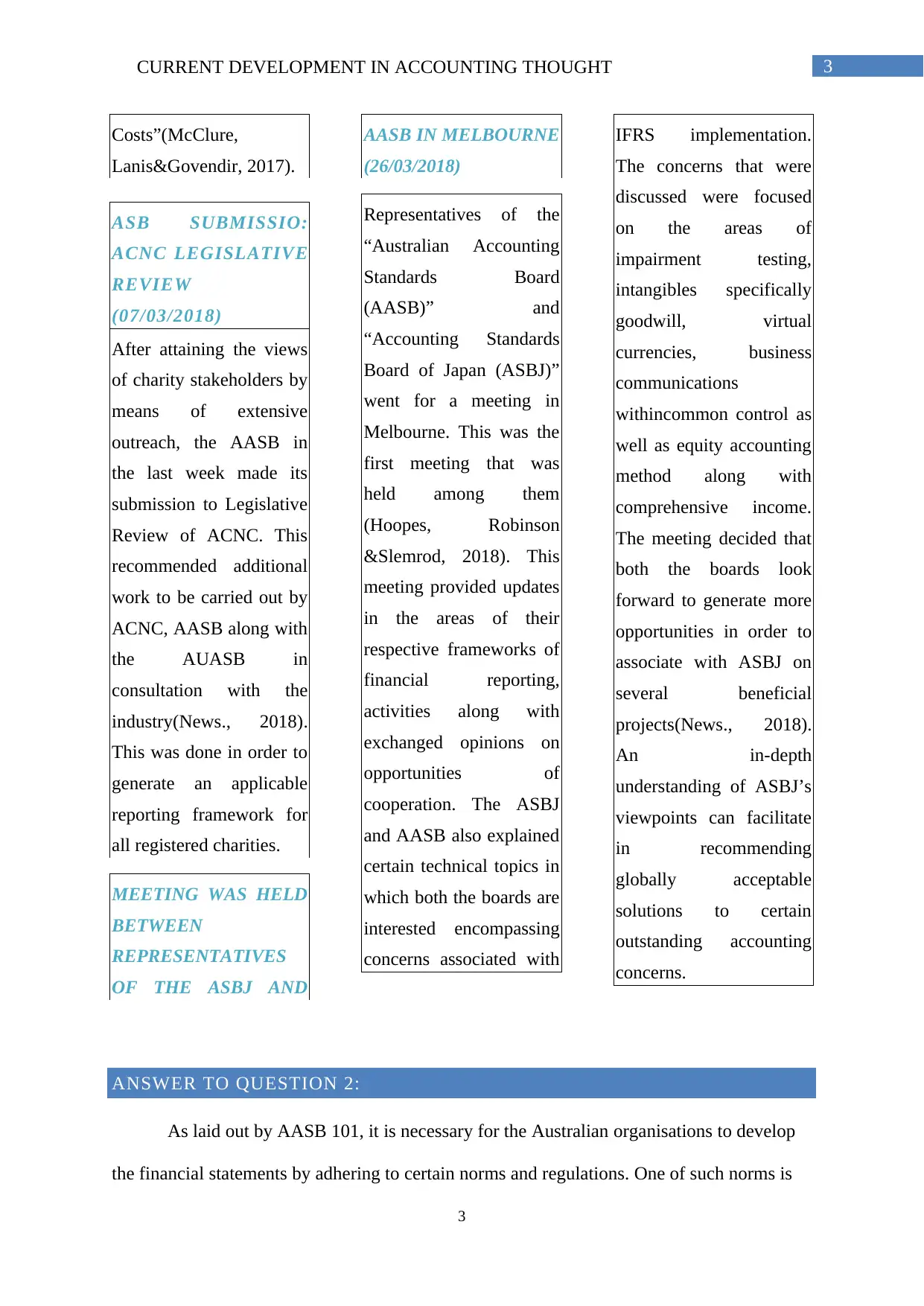
3CURRENT DEVELOPMENT IN ACCOUNTING THOUGHT
Costs”(McClure,
Lanis&Govendir, 2017).
ASB SUBMISSIO:
ACNC LEGISLATIVE
REVIEW
(07/03/2018)
After attaining the views
of charity stakeholders by
means of extensive
outreach, the AASB in
the last week made its
submission to Legislative
Review of ACNC. This
recommended additional
work to be carried out by
ACNC, AASB along with
the AUASB in
consultation with the
industry(News., 2018).
This was done in order to
generate an applicable
reporting framework for
all registered charities.
MEETING WAS HELD
BETWEEN
REPRESENTATIVES
OF THE ASBJ AND
AASB IN MELBOURNE
(26/03/2018)
Representatives of the
“Australian Accounting
Standards Board
(AASB)” and
“Accounting Standards
Board of Japan (ASBJ)”
went for a meeting in
Melbourne. This was the
first meeting that was
held among them
(Hoopes, Robinson
&Slemrod, 2018). This
meeting provided updates
in the areas of their
respective frameworks of
financial reporting,
activities along with
exchanged opinions on
opportunities of
cooperation. The ASBJ
and AASB also explained
certain technical topics in
which both the boards are
interested encompassing
concerns associated with
IFRS implementation.
The concerns that were
discussed were focused
on the areas of
impairment testing,
intangibles specifically
goodwill, virtual
currencies, business
communications
withincommon control as
well as equity accounting
method along with
comprehensive income.
The meeting decided that
both the boards look
forward to generate more
opportunities in order to
associate with ASBJ on
several beneficial
projects(News., 2018).
An in-depth
understanding of ASBJ’s
viewpoints can facilitate
in recommending
globally acceptable
solutions to certain
outstanding accounting
concerns.
ANSWER TO QUESTION 2:
As laid out by AASB 101, it is necessary for the Australian organisations to develop
the financial statements by adhering to certain norms and regulations. One of such norms is
3
Costs”(McClure,
Lanis&Govendir, 2017).
ASB SUBMISSIO:
ACNC LEGISLATIVE
REVIEW
(07/03/2018)
After attaining the views
of charity stakeholders by
means of extensive
outreach, the AASB in
the last week made its
submission to Legislative
Review of ACNC. This
recommended additional
work to be carried out by
ACNC, AASB along with
the AUASB in
consultation with the
industry(News., 2018).
This was done in order to
generate an applicable
reporting framework for
all registered charities.
MEETING WAS HELD
BETWEEN
REPRESENTATIVES
OF THE ASBJ AND
AASB IN MELBOURNE
(26/03/2018)
Representatives of the
“Australian Accounting
Standards Board
(AASB)” and
“Accounting Standards
Board of Japan (ASBJ)”
went for a meeting in
Melbourne. This was the
first meeting that was
held among them
(Hoopes, Robinson
&Slemrod, 2018). This
meeting provided updates
in the areas of their
respective frameworks of
financial reporting,
activities along with
exchanged opinions on
opportunities of
cooperation. The ASBJ
and AASB also explained
certain technical topics in
which both the boards are
interested encompassing
concerns associated with
IFRS implementation.
The concerns that were
discussed were focused
on the areas of
impairment testing,
intangibles specifically
goodwill, virtual
currencies, business
communications
withincommon control as
well as equity accounting
method along with
comprehensive income.
The meeting decided that
both the boards look
forward to generate more
opportunities in order to
associate with ASBJ on
several beneficial
projects(News., 2018).
An in-depth
understanding of ASBJ’s
viewpoints can facilitate
in recommending
globally acceptable
solutions to certain
outstanding accounting
concerns.
ANSWER TO QUESTION 2:
As laid out by AASB 101, it is necessary for the Australian organisations to develop
the financial statements by adhering to certain norms and regulations. One of such norms is
3
⊘ This is a preview!⊘
Do you want full access?
Subscribe today to unlock all pages.

Trusted by 1+ million students worldwide
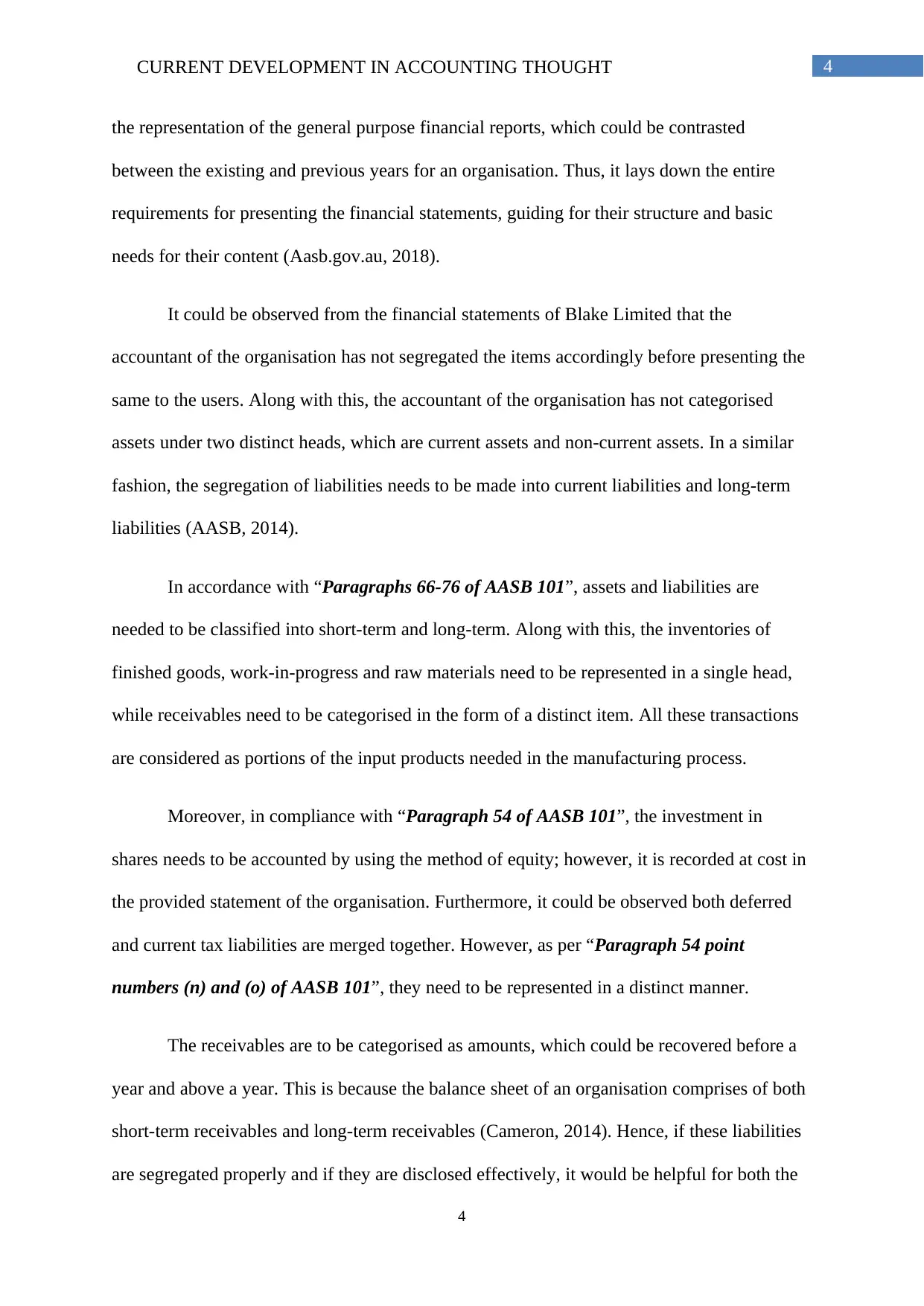
4CURRENT DEVELOPMENT IN ACCOUNTING THOUGHT
the representation of the general purpose financial reports, which could be contrasted
between the existing and previous years for an organisation. Thus, it lays down the entire
requirements for presenting the financial statements, guiding for their structure and basic
needs for their content (Aasb.gov.au, 2018).
It could be observed from the financial statements of Blake Limited that the
accountant of the organisation has not segregated the items accordingly before presenting the
same to the users. Along with this, the accountant of the organisation has not categorised
assets under two distinct heads, which are current assets and non-current assets. In a similar
fashion, the segregation of liabilities needs to be made into current liabilities and long-term
liabilities (AASB, 2014).
In accordance with “Paragraphs 66-76 of AASB 101”, assets and liabilities are
needed to be classified into short-term and long-term. Along with this, the inventories of
finished goods, work-in-progress and raw materials need to be represented in a single head,
while receivables need to be categorised in the form of a distinct item. All these transactions
are considered as portions of the input products needed in the manufacturing process.
Moreover, in compliance with “Paragraph 54 of AASB 101”, the investment in
shares needs to be accounted by using the method of equity; however, it is recorded at cost in
the provided statement of the organisation. Furthermore, it could be observed both deferred
and current tax liabilities are merged together. However, as per “Paragraph 54 point
numbers (n) and (o) of AASB 101”, they need to be represented in a distinct manner.
The receivables are to be categorised as amounts, which could be recovered before a
year and above a year. This is because the balance sheet of an organisation comprises of both
short-term receivables and long-term receivables (Cameron, 2014). Hence, if these liabilities
are segregated properly and if they are disclosed effectively, it would be helpful for both the
4
the representation of the general purpose financial reports, which could be contrasted
between the existing and previous years for an organisation. Thus, it lays down the entire
requirements for presenting the financial statements, guiding for their structure and basic
needs for their content (Aasb.gov.au, 2018).
It could be observed from the financial statements of Blake Limited that the
accountant of the organisation has not segregated the items accordingly before presenting the
same to the users. Along with this, the accountant of the organisation has not categorised
assets under two distinct heads, which are current assets and non-current assets. In a similar
fashion, the segregation of liabilities needs to be made into current liabilities and long-term
liabilities (AASB, 2014).
In accordance with “Paragraphs 66-76 of AASB 101”, assets and liabilities are
needed to be classified into short-term and long-term. Along with this, the inventories of
finished goods, work-in-progress and raw materials need to be represented in a single head,
while receivables need to be categorised in the form of a distinct item. All these transactions
are considered as portions of the input products needed in the manufacturing process.
Moreover, in compliance with “Paragraph 54 of AASB 101”, the investment in
shares needs to be accounted by using the method of equity; however, it is recorded at cost in
the provided statement of the organisation. Furthermore, it could be observed both deferred
and current tax liabilities are merged together. However, as per “Paragraph 54 point
numbers (n) and (o) of AASB 101”, they need to be represented in a distinct manner.
The receivables are to be categorised as amounts, which could be recovered before a
year and above a year. This is because the balance sheet of an organisation comprises of both
short-term receivables and long-term receivables (Cameron, 2014). Hence, if these liabilities
are segregated properly and if they are disclosed effectively, it would be helpful for both the
4
Paraphrase This Document
Need a fresh take? Get an instant paraphrase of this document with our AI Paraphraser
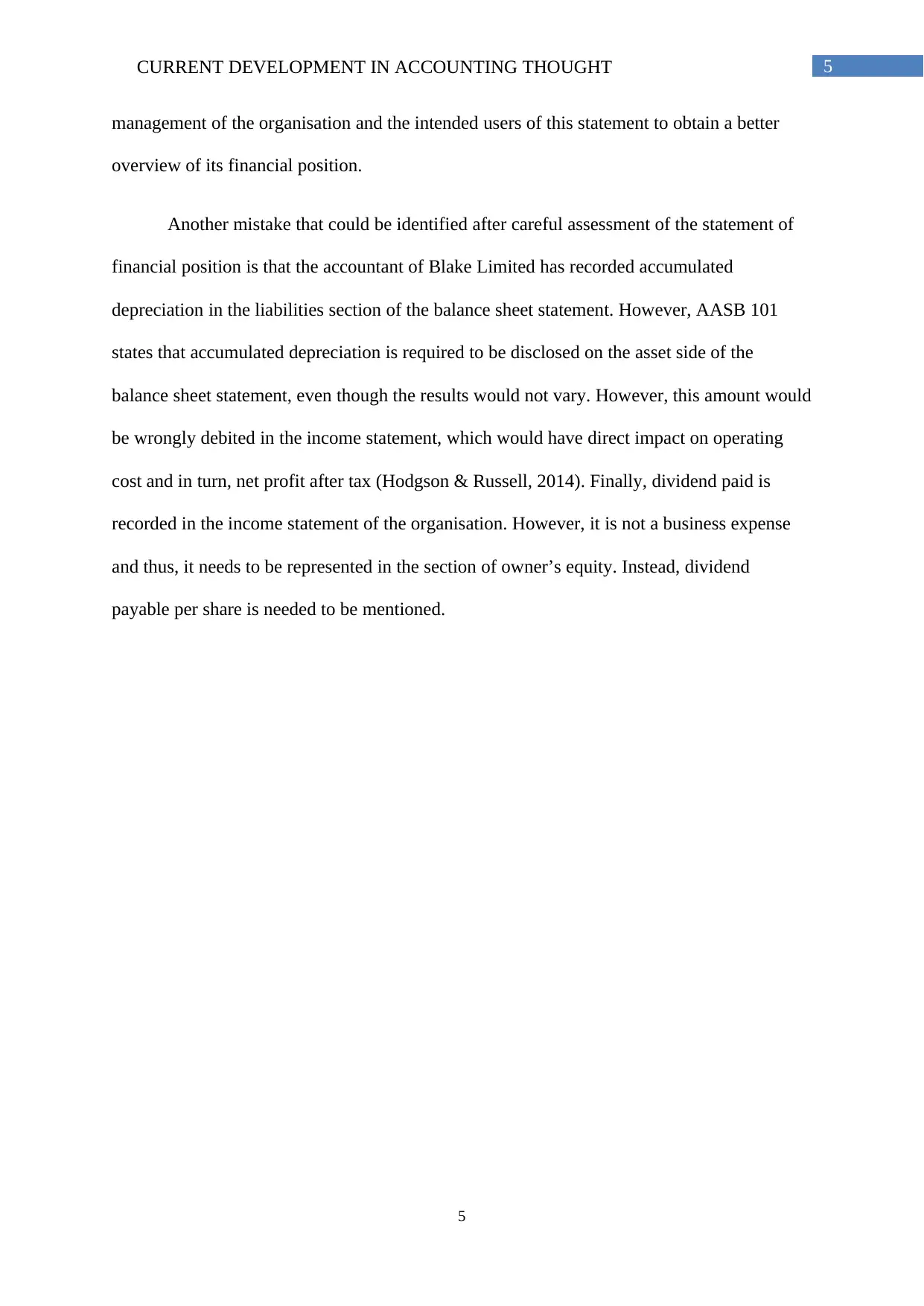
5CURRENT DEVELOPMENT IN ACCOUNTING THOUGHT
management of the organisation and the intended users of this statement to obtain a better
overview of its financial position.
Another mistake that could be identified after careful assessment of the statement of
financial position is that the accountant of Blake Limited has recorded accumulated
depreciation in the liabilities section of the balance sheet statement. However, AASB 101
states that accumulated depreciation is required to be disclosed on the asset side of the
balance sheet statement, even though the results would not vary. However, this amount would
be wrongly debited in the income statement, which would have direct impact on operating
cost and in turn, net profit after tax (Hodgson & Russell, 2014). Finally, dividend paid is
recorded in the income statement of the organisation. However, it is not a business expense
and thus, it needs to be represented in the section of owner’s equity. Instead, dividend
payable per share is needed to be mentioned.
5
management of the organisation and the intended users of this statement to obtain a better
overview of its financial position.
Another mistake that could be identified after careful assessment of the statement of
financial position is that the accountant of Blake Limited has recorded accumulated
depreciation in the liabilities section of the balance sheet statement. However, AASB 101
states that accumulated depreciation is required to be disclosed on the asset side of the
balance sheet statement, even though the results would not vary. However, this amount would
be wrongly debited in the income statement, which would have direct impact on operating
cost and in turn, net profit after tax (Hodgson & Russell, 2014). Finally, dividend paid is
recorded in the income statement of the organisation. However, it is not a business expense
and thus, it needs to be represented in the section of owner’s equity. Instead, dividend
payable per share is needed to be mentioned.
5
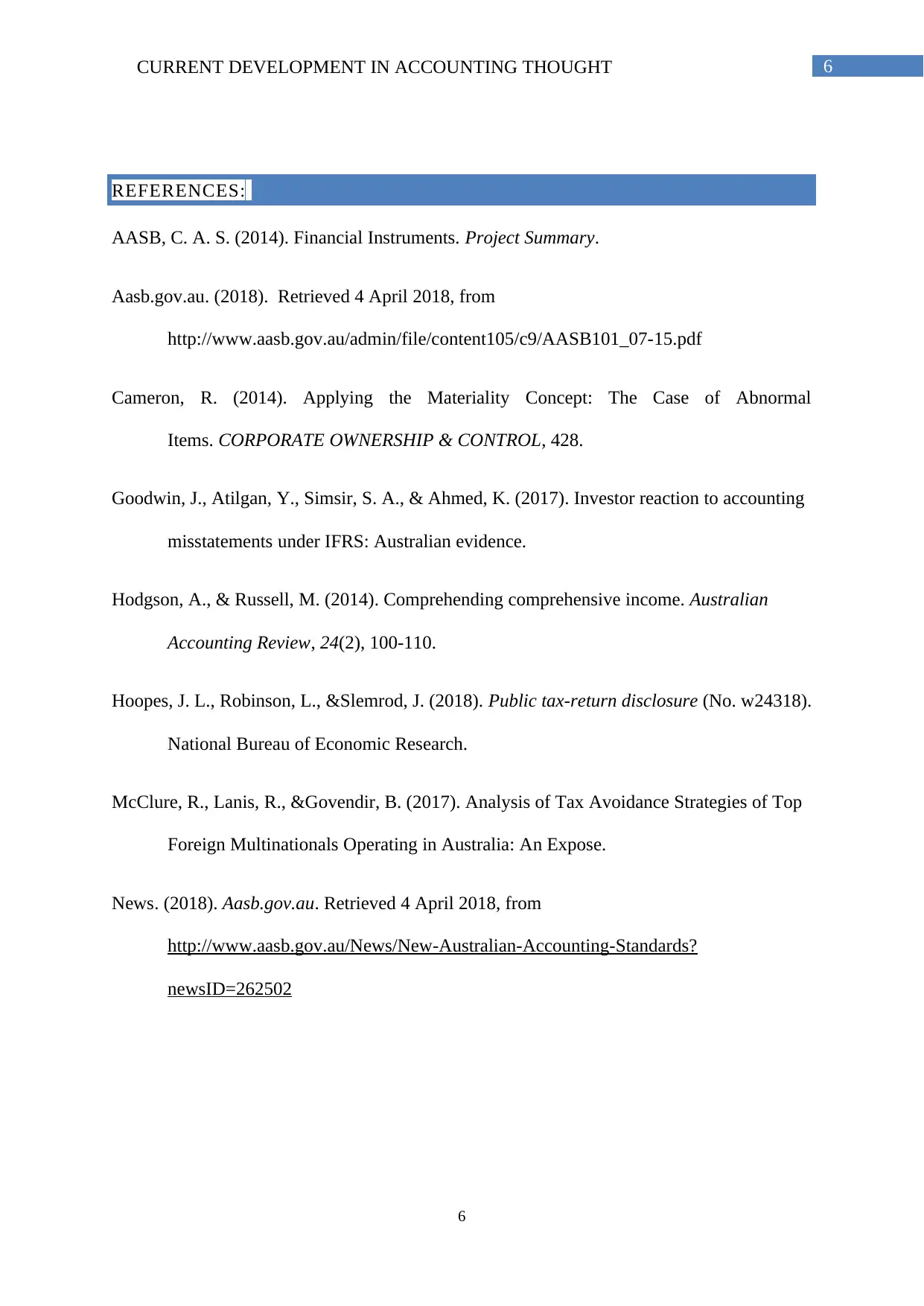
6CURRENT DEVELOPMENT IN ACCOUNTING THOUGHT
REFERENCES::
AASB, C. A. S. (2014). Financial Instruments. Project Summary.
Aasb.gov.au. (2018). Retrieved 4 April 2018, from
http://www.aasb.gov.au/admin/file/content105/c9/AASB101_07-15.pdf
Cameron, R. (2014). Applying the Materiality Concept: The Case of Abnormal
Items. CORPORATE OWNERSHIP & CONTROL, 428.
Goodwin, J., Atilgan, Y., Simsir, S. A., & Ahmed, K. (2017). Investor reaction to accounting
misstatements under IFRS: Australian evidence.
Hodgson, A., & Russell, M. (2014). Comprehending comprehensive income. Australian
Accounting Review, 24(2), 100-110.
Hoopes, J. L., Robinson, L., &Slemrod, J. (2018). Public tax-return disclosure (No. w24318).
National Bureau of Economic Research.
McClure, R., Lanis, R., &Govendir, B. (2017). Analysis of Tax Avoidance Strategies of Top
Foreign Multinationals Operating in Australia: An Expose.
News. (2018). Aasb.gov.au. Retrieved 4 April 2018, from
http://www.aasb.gov.au/News/New-Australian-Accounting-Standards?
newsID=262502
6
REFERENCES::
AASB, C. A. S. (2014). Financial Instruments. Project Summary.
Aasb.gov.au. (2018). Retrieved 4 April 2018, from
http://www.aasb.gov.au/admin/file/content105/c9/AASB101_07-15.pdf
Cameron, R. (2014). Applying the Materiality Concept: The Case of Abnormal
Items. CORPORATE OWNERSHIP & CONTROL, 428.
Goodwin, J., Atilgan, Y., Simsir, S. A., & Ahmed, K. (2017). Investor reaction to accounting
misstatements under IFRS: Australian evidence.
Hodgson, A., & Russell, M. (2014). Comprehending comprehensive income. Australian
Accounting Review, 24(2), 100-110.
Hoopes, J. L., Robinson, L., &Slemrod, J. (2018). Public tax-return disclosure (No. w24318).
National Bureau of Economic Research.
McClure, R., Lanis, R., &Govendir, B. (2017). Analysis of Tax Avoidance Strategies of Top
Foreign Multinationals Operating in Australia: An Expose.
News. (2018). Aasb.gov.au. Retrieved 4 April 2018, from
http://www.aasb.gov.au/News/New-Australian-Accounting-Standards?
newsID=262502
6
⊘ This is a preview!⊘
Do you want full access?
Subscribe today to unlock all pages.

Trusted by 1+ million students worldwide
1 out of 6
Related Documents
Your All-in-One AI-Powered Toolkit for Academic Success.
+13062052269
info@desklib.com
Available 24*7 on WhatsApp / Email
![[object Object]](/_next/static/media/star-bottom.7253800d.svg)
Unlock your academic potential
Copyright © 2020–2025 A2Z Services. All Rights Reserved. Developed and managed by ZUCOL.



